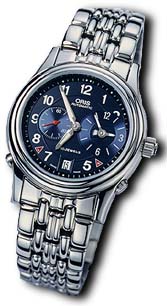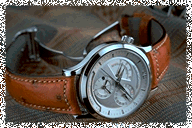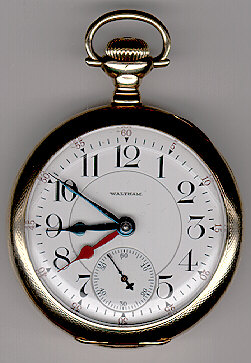

My criteria for a travel watch is as follows:
 The Oris Worldtimer. Movement: Oris Cal. 690 which is an Oris development over an ETA 2836-2. In Stainless steel case/bracelet, sapphire glass crystal, and mineral glass display back. |
After a long time musing, and thinking over the various options available, I arrived at purchasing an Oris Worldtimer, blue dial, bracelet in SS of course. It meets all the above criteria and I get +5s a day, so it is fairly accurate...not wonderfully so, but sufficient. I think the Worldtimer is a great watch. The finishing is not great, but it has no pretentions to be so. I would consider it good, especially in price range. The bracelet's shiny finish is a little tasteless, and I would have preferred a buff finish. It looks more stunning with the blue strap, but a travel watch must take a lot of sweating, especially when I have to lug baggage in strange airports, or be in humid climate. |
Here are some of the other watches I considered:
I have hesitated long against buying the AP Dual Time as I really like the RO look. But the Royal Oak Dual Time shows the local time indication at the small dial at six, while displaying home time on the large dial. I think, for a travel utility watch, this is not acceptable. The lack of a quick date set, and the lack of a seconds hand further makes it less attractive. Of course, a RO being quite recognisable as an expensive watch may catch the eyes of the local low-life too easily for comfort...
| Although the JLC Master Geographique is probably many an enthusiast's choice, I have shunned it. It suffers from the same small local/large home time dial arrangement. Also, I feel the city dial, visible in an aperture on the dial at 6 is superflous. And I can't find Singapore (hey I live here!) and other cities I frequent on it. The JLC's movement is of course first rate, and the rathr discrete design of the case should render it quite safe.
I have given the JLC Reverso DuoTime a miss, as I dislike rectangular cases...though the dual face is rather elegant. |  The Jaeger Le-Coultre Master Geographique |
 |
Another interesting watch is the Patek Phillipe has the World Traveller. I think the Patek is perhaps less rugged...or at least I would perceive it to be so considering its cost. And of course, is would be a little too much a flash in the eyes of the local toughies in the places I travel to. Although, the movement is first rate, and the uncluttered design of the dial elegant. I especially like the hidden gold hour hand which is used to indicate home time during travel, hidden normally. But the Patek lacks a day/night indicator for the home time, which is useful for figuring out whether it is a good time to make that phone call home. One new entrant is the GP WorldTime, which has the additional bonus of an alarm...very useful for waking up, or reminding me of the pending airplane departure times. I am not too excited of its looks, and would be still more comfortable with an entry level, low cost watch like the Oris Worldtimer. Other options include the Rolex Explorer II or the GMT series. My reasons for rejecting these is that they use a single 24hour hand to indicate the home time, which is often non-intuitive. Daniel Roth also makes a dual timezone watch housed in the classically exquisite Roth case. But I feel that it is easy to confuse the home time with the date. I suppose after a period of acclimatization, I would get used to it, but I think perhaps it could be clearer. Ulysee Nardin GMT+/- comes close to the Worldtimer. It too has twin pushers which allows the local time to advance or retard in hourly quantums without affecting the running of the watch. And the home time is displayed in 24 hour fashion in a window perforation at 10 o'clock. But the UN lacks the ease to forward and reverse the date as with the Oris. |
But dual timezone watches are not new...the picture above shows the Waltham Dual Timezone pocket railroad watch, used by train masters in the early half of the 20th century. Note similarity to the Patek's World Traveller's use of two hour hands.
This page was created by Peter Chong. Last updated June 8, 1998.